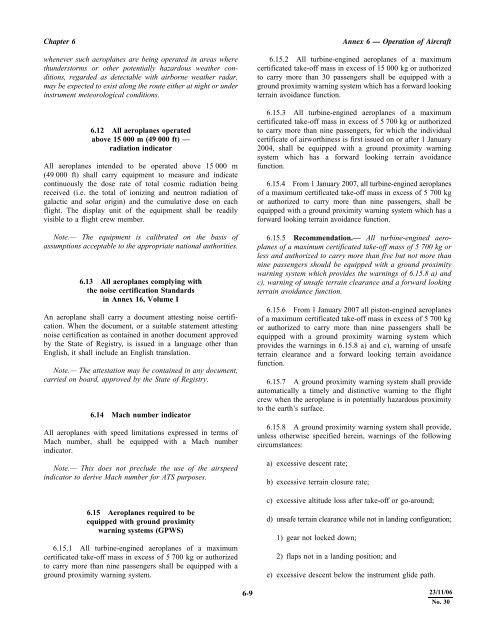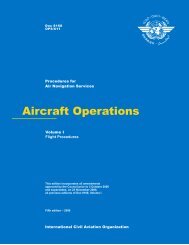Operation of Aircraft
Annex 6, Part I
Annex 6, Part I
- No tags were found...
Create successful ePaper yourself
Turn your PDF publications into a flip-book with our unique Google optimized e-Paper software.
Chapter 6<br />
whenever such aeroplanes are being operated in areas where<br />
thunderstorms or other potentially hazardous weather conditions,<br />
regarded as detectable with airborne weather radar,<br />
may be expected to exist along the route either at night or under<br />
instrument meteorological conditions.<br />
6.12 All aeroplanes operated<br />
above 15 000 m (49 000 ft) —<br />
radiation indicator<br />
All aeroplanes intended to be operated above 15 000 m<br />
(49 000 ft) shall carry equipment to measure and indicate<br />
continuously the dose rate <strong>of</strong> total cosmic radiation being<br />
received (i.e. the total <strong>of</strong> ionizing and neutron radiation <strong>of</strong><br />
galactic and solar origin) and the cumulative dose on each<br />
flight. The display unit <strong>of</strong> the equipment shall be readily<br />
visible to a flight crew member.<br />
Note.— The equipment is calibrated on the basis <strong>of</strong><br />
assumptions acceptable to the appropriate national authorities.<br />
6.13 All aeroplanes complying with<br />
the noise certification Standards<br />
in Annex 16, Volume I<br />
An aeroplane shall carry a document attesting noise certification.<br />
When the document, or a suitable statement attesting<br />
noise certification as contained in another document approved<br />
by the State <strong>of</strong> Registry, is issued in a language other than<br />
English, it shall include an English translation.<br />
Note.— The attestation may be contained in any document,<br />
carried on board, approved by the State <strong>of</strong> Registry.<br />
6.14 Mach number indicator<br />
All aeroplanes with speed limitations expressed in terms <strong>of</strong><br />
Mach number, shall be equipped with a Mach number<br />
indicator.<br />
Note.— This does not preclude the use <strong>of</strong> the airspeed<br />
indicator to derive Mach number for ATS purposes.<br />
6.15 Aeroplanes required to be<br />
equipped with ground proximity<br />
warning systems (GPWS)<br />
6.15.1 All turbine-engined aeroplanes <strong>of</strong> a maximum<br />
certificated take-<strong>of</strong>f mass in excess <strong>of</strong> 5 700 kg or authorized<br />
to carry more than nine passengers shall be equipped with a<br />
ground proximity warning system.<br />
Annex 6 — <strong>Operation</strong> <strong>of</strong> <strong>Aircraft</strong><br />
6.15.2 All turbine-engined aeroplanes <strong>of</strong> a maximum<br />
certificated take-<strong>of</strong>f mass in excess <strong>of</strong> 15 000 kg or authorized<br />
to carry more than 30 passengers shall be equipped with a<br />
ground proximity warning system which has a forward looking<br />
terrain avoidance function.<br />
6.15.3 All turbine-engined aeroplanes <strong>of</strong> a maximum<br />
certificated take-<strong>of</strong>f mass in excess <strong>of</strong> 5 700 kg or authorized<br />
to carry more than nine passengers, for which the individual<br />
certificate <strong>of</strong> airworthiness is first issued on or after 1 January<br />
2004, shall be equipped with a ground proximity warning<br />
system which has a forward looking terrain avoidance<br />
function.<br />
6.15.4 From 1 January 2007, all turbine-engined aeroplanes<br />
<strong>of</strong> a maximum certificated take-<strong>of</strong>f mass in excess <strong>of</strong> 5 700 kg<br />
or authorized to carry more than nine passengers, shall be<br />
equipped with a ground proximity warning system which has a<br />
forward looking terrain avoidance function.<br />
6.15.5 Recommendation.— All turbine-engined aeroplanes<br />
<strong>of</strong> a maximum certificated take-<strong>of</strong>f mass <strong>of</strong> 5 700 kg or<br />
less and authorized to carry more than five but not more than<br />
nine passengers should be equipped with a ground proximity<br />
warning system which provides the warnings <strong>of</strong> 6.15.8 a) and<br />
c), warning <strong>of</strong> unsafe terrain clearance and a forward looking<br />
terrain avoidance function.<br />
6.15.6 From 1 January 2007 all piston-engined aeroplanes<br />
<strong>of</strong> a maximum certificated take-<strong>of</strong>f mass in excess <strong>of</strong> 5 700 kg<br />
or authorized to carry more than nine passengers shall be<br />
equipped with a ground proximity warning system which<br />
provides the warnings in 6.15.8 a) and c), warning <strong>of</strong> unsafe<br />
terrain clearance and a forward looking terrain avoidance<br />
function.<br />
6.15.7 A ground proximity warning system shall provide<br />
automatically a timely and distinctive warning to the flight<br />
crew when the aeroplane is in potentially hazardous proximity<br />
to the earth’s surface.<br />
6.15.8 A ground proximity warning system shall provide,<br />
unless otherwise specified herein, warnings <strong>of</strong> the following<br />
circumstances:<br />
a) excessive descent rate;<br />
b) excessive terrain closure rate;<br />
c) excessive altitude loss after take-<strong>of</strong>f or go-around;<br />
d) unsafe terrain clearance while not in landing configuration;<br />
1) gear not locked down;<br />
2) flaps not in a landing position; and<br />
e) excessive descent below the instrument glide path.<br />
6-9 1/11/01<br />
23/11/06<br />
No. 30












